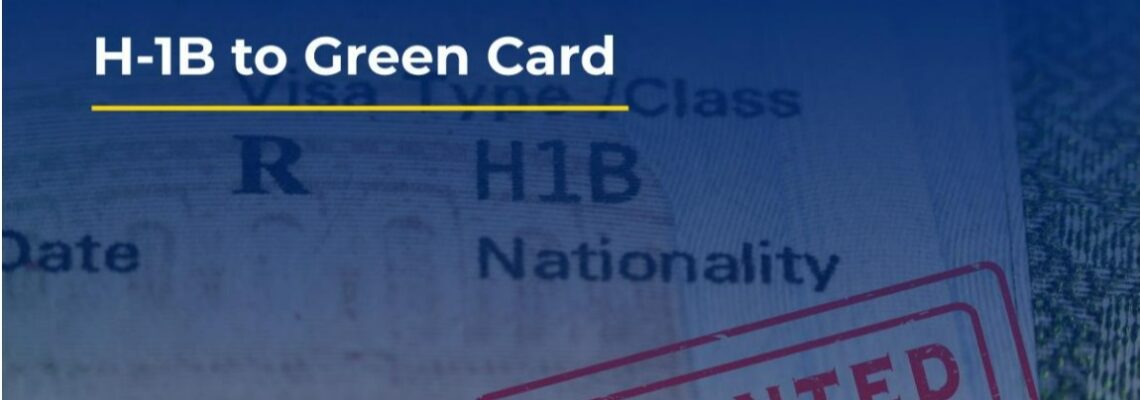Visa
The Guide To Converting A H1B Visa To A Green Card

The process of getting a Green Card through employment is called the H-1B to Green Card transfer.
Most US non-immigrant work visas are H1Bs. The visa holder has a desired job and has completed considerable education and training. H1B visas last six years. They must come home after six years. Employees have 10 days to return or extend their H1B visa in the US.
Most H1B visa holders request US citizenship. Get an American Green Card. Dual-intent H1B visa holders can petition for permanent residency.
H1B to Green Card transfers or Employment Based Green Cards allow H1B visa holders to get US green cards. Other Green Cards include:
- Family Based Green Card
- Political Asylum Based Green Card
- Adoption Based Green Card
- Refugee Based Green Card
- Diversity Based Green Card
Employment-based Green Cards might take months or years. Agencies require many processes and documentation. Most agencies advise employing an attorney because the process might be complicated. They can help with paperwork and deadlines.
Most importantly, your US company must start the Employment Based Green Card procedure. Green Card applications cannot be started by employees or others.
Thus, before applying for a Green Card, you must find a US employer to hire and sponsor you.
H1B to Green Card Process
Here are the steps of the H1B to Green Card process:
- Get PERM Labor Certification.
- File Form I-140, Immigrant Petition for Alien Worker.
- File Form I-485, Adjustment of Status.
Step 1: Get PERM Labor Certification
The US created the PERM in 2005 to simplify Employment-Based Green Card applications. PERM is connected to the DOL. Electronic applications save time and paper.
Employers need DOL PERM Certification to start the Green Card process for their employees. These steps:
- Registering with DOL
- Getting approval for a prevailing wage determination
- Conducting recruitment processes
- Filing ETA Form 9089
- Obtaining PERM decision
Registering with DOL
Each employer who wants to sponsor a foreign worker to get their Green Card from an H1B visa status has to register with the DOL. After completing the online form, they will get their user ID, a password, and PIN number from the DOL in their email.
The DOL has created a guide on how to register online, which employers can follow.
Getting approval for Prevailing Wage Determination
The DOL compels employers to pay foreign workers the prevailing wage. They will pay the state-mandated wage, not less. SESAs and SWAs provide prevailing wage certification to employers.
The DOL can receive it after certification. Filed certifications must be valid.
Conducting Recruitment Processes
Employers must demonstrate to the DOL that they were unable to obtain a competent US citizen for the employment position after receiving certification for the prevailing wage decision. As a result, they must recruit a foreign worker and wish to sponsor the worker for a Green Card.
Employers must use the following methods to demonstrate that no US citizen fits the requirements:
- Place 2 newspaper print ads for 3 consecutive days, one of which has to be a Sunday. The ad has to be in a newspaper which circulates in the geographic area where the work will be performed.
- They may place a national journal ad instead of one of the newspaper ads
- In addition, they should also conduct another recruitment process such as:
- Place a website ad
- Conduct on campus recruiting
- Participate in job fairs
- Place radio or TV ads, etc.
- In any ad, the job title, detailed description, requirements, and employer name must be visible
After these recruitment processes, they must disclose to the DOL that no US citizen was suitable for the job. The employer’s US employee recruitment efforts and results must be reported. They must explain why US citizens were refused. Employers need also show that they considered laid-off foreign workers before hiring a new H1B employee and sponsoring them for the Green Card.
The DOL can supervise the recruitment process. For DOL audits, employers must preserve recruitment files for 5 years.
File ETA Form 9089
Following the prevailing wage determination and recruitment, the employer must file the ETA Form 9089. This form is the Application for Employment Certification. It can be filed either by mail or electronically.
The form should prove that the employer has fulfilled all requirements and that the job position is appropriate for the foreign worker to go from an H1B to Green Card.
Obtaining PERM decision
After the DOL officers review all documents, they can either approve or deny the PERM certification. In some cases, they might require an audit or additional documents to reach a decision. Applicants can expect PERM decision to be made within 45 to 60 days of application.
Step 2: File Form I-140
The Immigrant Petition for Alien Worker (I-140) is the next stage from H1B to Green Card. The I-140 form confirms that the person is eligible to work and live in the US permanently and will get the advertised wage after PERM approval.
Form I-140 gives employers a visa number and date. Priority dates reflect case processing. If that date is current, the employee can file Form I-485 with Form I-140. Concurrent filing occurs.
Step3: File Form I-485
H1B to Green Card procedure ends with employee filing for Adjustment of Status. Form I-485, Application to Register Permanent Residence or Adjust Status, does this.
If accepted by USCIS, this form allows the employee to legally work and live in the US. Adjustment of Status is filed two ways:
US workers need only file form I-485. They only need a valid H1B visa to apply. If the visa expires, they must return home. Only if the employee has an approved I-140 with a non-current date. They will receive infinite extensions till the operation is complete.
Employees working abroad must undergo consular procedures. Consular processing involves the employee applying for status modification at their local US Embassy. Consular processing requires these steps:
- After the employer petitions with USCIS and gets approval, USCIS sends the application to the National Visa Center (NVC)
- NVC assigns a case number and sends it to the employer and employee
- When your priority date becomes current, the NVC will send you the applicable fees to be paid
- Then it will send you to complete the Affidavit of Support otherwise called a Form I-864 (costs approx. $700)
- NVC will also send you to complete Form DS-3032 or Choice of Address and Agent. Those who are processing the H1B to Green
- Card electronically will have to complete Form DS-261 instead of DS-3032.
- After you complete these forms, you should send them back to the NVC for processing
- NVC will then send you Form IV or Instructions Package for Immigrant Visa Applicants, which costs approximately $400
- After reviewing all documents, the applicant is called for an interview. The accompanying family members should be there too, and prior to the interview should go through visa medical examination.
After all the procedures, whether the applicant is in the US or outside, USCIS will process the documents and inform of their decision. If your application is approved, you will get a stamp in your passport and then later the physical Green Card. You will have successfully transferred from an H1B to a Green Card permanent US resident.
Should I Get Health Insurance After I Receive My Green Card?
Yes, it is advisable that you purchase a health insurance policy due to the high costs of healthcare in the United States. Here you can find more information about health insurance plans for Green Card holders.
Categories of Employment Based Green Cards
Every year, around 140,000 persons are eligible for an Employment-Based Green Card. Each country receives 7% (9,800 persons) of this quota, regardless of size. There are five types of employees who can apply to transition from H1B to Green Card status. Each of them receives a portion of the 140,000 quota. The following are the categories:
E-B1 or Priority Workers
The EB1 category is the one which most people want to apply but few qualify for it. The priority dates are usually current so they get processed quite quickly. Those who qualify for E-B1 are:
- Exceptional professors and researchers
- Managers and executives
- Those with extraordinary abilities in business, arts, sciences, education, or athletics
- Each country gets 2,802 of these visas plus the visas not used for E-B4 and EB5.
E-B2 or Professionals with exceptional ability or advanced degrees
Annually around 2,802 visas plus those not used for E-B1 are given to E-B2 applicants. These include:
- Those with extraordinary abilities in art, business, and science
- Those with advanced degrees (Masters of PhD degrees)
- Physicians who will serve in underserved areas in the US
E-B3 or Skilled/Professional Workers
This category gets another 2,802 visas plus those not used by E-B2. The following qualify for an EB3 Green Card:
- Those with Bachelor Degrees
- Skilled workers who have a minimum of two years experience or training
- Unskilled workers
E-B4 or Special Immigrants
The E-B4 category gets 695 visas annually and those who qualify are:
- Those who are working or have previously worked for the US government abroad
- Religious workers
- Those who work for US Armed Forces as translators
E-B5 or Investors
No more than 3,000 visas are reserved for the E-B5 category. Those who qualify are investors who will create at least 10 full time jobs in the US and invest from $500,000 to $1,000,000 in the US economy.
H1B to Green Card Fees
Obtaining an Employment-Based Green Card is costly. Fees must be paid by both the employer or sponsor and the employee. The following are the fees that must be paid:
- Attorney Fees – Employers have to pay $2,000 to $5,000 for the attorney to file the PERM certification. A few thousand dollars are also required for them to file the I-140 and I-485 forms. The fees for these two forms can be paid by the employer or employee.
- Advertisement fees – which depend on the state and medium used to advertise for the job position. Fees range from hundreds to thousands of dollars. These fees must be paid by the employer.
- Application fees – The I-140 application fee is $580 and the I-485 is $1,070 for each employee. These fees can be paid by either the employee or employer.
In general, applying for a Green Card using an H1B visa may cost up to $10,000. However, if accepted, the individual is permitted to live and work in the United States permanently.






















